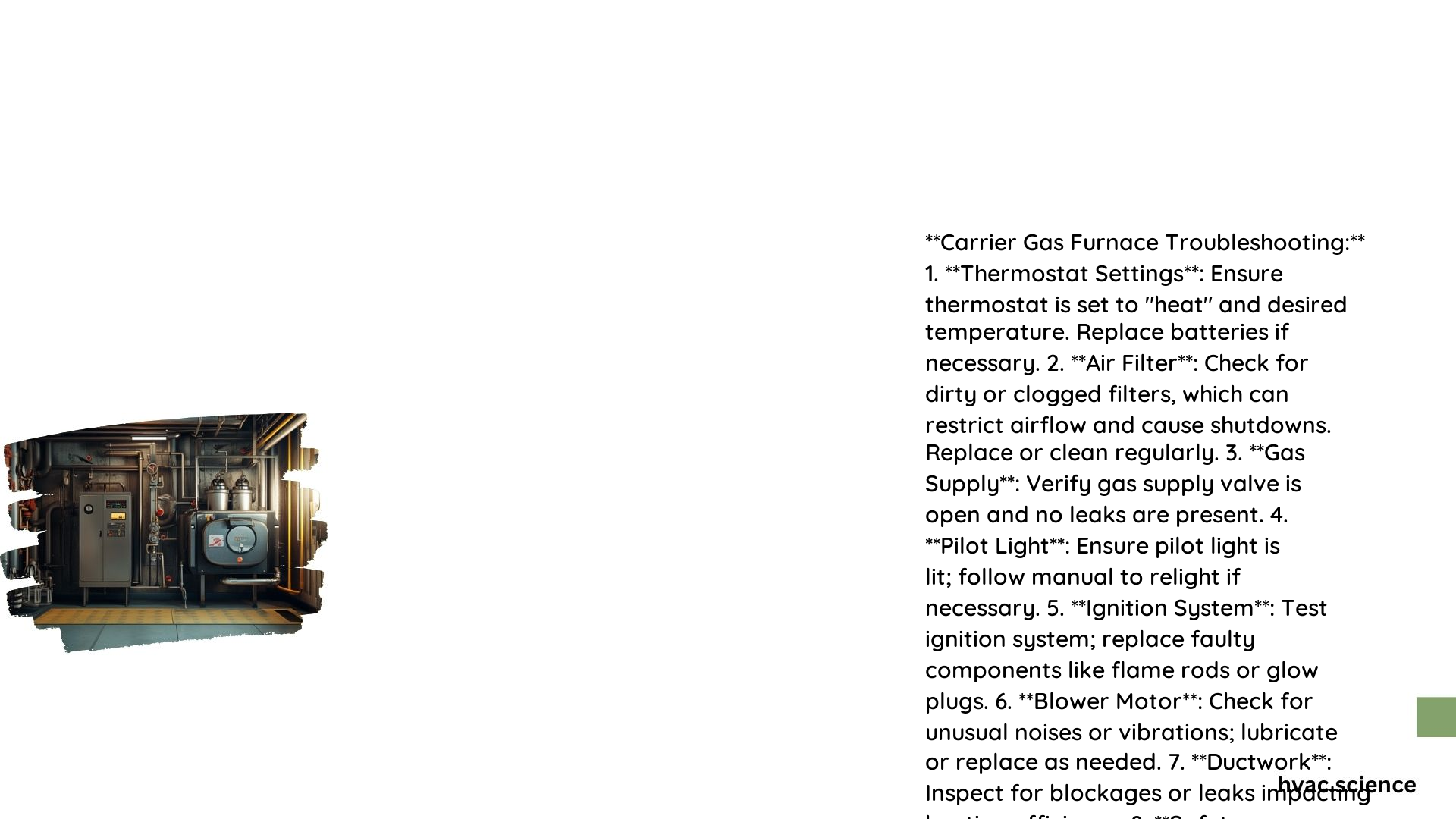Carrier gas furnaces are known for their reliability and energy efficiency, but like any appliance, they can experience issues from time to time. This comprehensive guide will walk you through the most common Carrier gas furnace problems and provide step-by-step troubleshooting solutions to help you get your heating system back up and running.
What Are the Common Issues Causing Malfunction?
What to Do If the Pilot Light Is Out?
If the pilot light is out, the furnace will not ignite. Check if the pilot light is lit and follow the manufacturer’s instructions to relight it if necessary.
How to Troubleshoot Thermostat Issues?
Ensure the thermostat is set to “heat” and the desired temperature. Replace batteries if the thermostat is battery-powered.
How to Check the Gas Supply?
Verify that the gas supply valve is open and there are no gas leaks.
Troubleshooting Steps for a Furnace That Won’t Turn On

How to Check the Power Supply?
- Ensure the furnace is receiving power. Check the circuit breaker or fuse box to see if the breaker has tripped or a fuse has blown.
- Verify that the furnace switch on the side of the unit’s cabinet is turned on.
How to Inspect Thermostat Settings?
- Ensure the thermostat is set to “heat” and the desired temperature. Adjust the temperature setting if necessary.
- Check if the thermostat batteries need to be replaced.
What to Do If the Circuit Breaker Has Tripped?
Check the circuit breaker to ensure it hasn’t tripped. If it has, reset it.
Troubleshooting Steps for a Furnace Not Producing Heat
How to Check the Air Filter?
A dirty or clogged air filter can restrict airflow and reduce efficiency. Clean or replace the filter as recommended by the manufacturer.
How to Ensure the Gas Valve Is Open?
Confirm that the gas supply valve is open and there are no gas leaks.
How to Inspect the Ignition System?
- Test the ignition system to ensure it’s functioning correctly. Replace faulty components if found.
- Check the ignitor for cracks or faults. If damaged, replace it.
What to Check in the Heat Registers and Ductwork?
Ensure all heat registers (vents) are open and unobstructed. Check for blockages or leaks in the ductwork.
What Are the Common Issues Requiring Professional Service?
What Are the Recurring Error Codes?
If your furnace displays error codes such as blinking yellow 3 (stuck in high fire mode) or blinking green 4 (stuck in low fire mode), it may indicate a problem that requires professional attention.
What Are the Unusual Noises?
Strange noises from the blower motor or other components may signal a need for professional inspection and repair.
What Are the Persistent Heating Problems?
Issues like soot build-up, faulty gas valves, or cracked heat exchangers require professional service to ensure safety and proper function.
What Maintenance Tasks Can Extend Furnace Life?
How Often Should You Change the Air Filter?
Clean or replace the furnace filter regularly according to the manufacturer’s recommendations (e.g., monthly for 1-inch filters, every three months for 4-inch filters).
How Often Should You Schedule Professional Inspections?
Schedule an annual inspection and cleaning with a qualified HVAC service specialist to maintain optimal performance and extend the furnace’s lifespan.
How to Clean the Blower Motor?
Keep the blower motor clean and lubricated as needed to prevent failures.
How to Troubleshoot Error Code 31?
What Does Error Code 31 Indicate?
Error Code 31 indicates a high-pressure switch fault.
What Are the Steps to Troubleshoot Error Code 31?
- Turn off power to the furnace at the circuit breaker or fuse box.
- Inspect the high-pressure switch for any blockages or malfunctions. Clean or replace it if necessary.
- Refer to the furnace’s manual for specific instructions on resetting or replacing the high-pressure switch.
What Are the Signs of a Faulty Flame Sensor?
What Are the Symptoms of a Faulty Flame Sensor?
- Intermittent heating: The furnace may turn on and off intermittently or fail to ignite.
- Frequent shut-offs: The furnace may shut off frequently due to the flame sensor not detecting the flame properly.
How to Clean the Flame Sensor?
What Tools Are Needed?
- A soft brush or cloth
- A screwdriver (if necessary to access the flame sensor)
- Safety gloves and goggles
What Are the Safety Precautions?
- Turn off the power to the furnace at the circuit breaker or fuse box.
- Ensure the furnace is cool before starting the cleaning process.
What Are the Step-by-Step Instructions?
- Access the flame sensor: Depending on the model, you may need to remove an access panel. Consult your furnace’s manual for specific instructions.
- Inspect and clean: Use a soft brush or cloth to gently clean the flame sensor. Remove any soot or debris that may be obstructing the sensor.
- Reassemble: Once cleaned, reassemble the furnace in the reverse order of how you disassembled it.
- Turn on power: Turn the power back on at the circuit breaker or fuse box and test the furnace to ensure it is working properly.
Reference Links
- Carrier Furnace Troubleshooting by HVAC.com
- Gas Furnace Repair by Carrier
- 18 Common Issues with Carrier Furnace: Troubleshooting Guide by HVAC Alliance Expert
